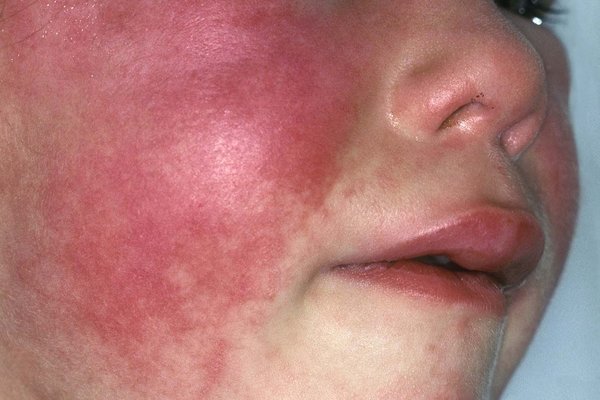10 Strep A facts
In this article, we will describe 10 Strep A facts and what is a strep A throat, and how you know if you have it.

Strep A causing a tonsillitis, with red swollen tonsils and pus in them
Terminology
‘Strep A’ is an abbreviation for a bacteria called Group A Streptococcus (Streptococcus pyogenes; also called ‘group A strep’ or ‘GAS’).
‘Strep throat’ is a throat infection (pharyngitis) – which shows itself as a sore throat – caused by strep A bacteria. Strep A can cause other infections, including skin infections (impetigo and scarlet fever), rheumatic fever (heart valve infection), and other infections (see list at end of the linked article).
Key Points
- Strep A (Group A Streptococcus, or GAS) is a common bacterial infection that can lead to a range of illnesses, from mild pharyngitis to severe invasive infections.
- Known for causing strep throat, scarlet fever, impetigo, and invasive diseases like necrotising fasciitis, Strep A is highly contagious, spreading primarily through respiratory droplets.
- Early diagnosis and treatment with antibiotics are essential to prevent complications, particularly in vulnerable populations.
- Vaccination does not currently exist for Strep A
- Prevention focuses on hygiene measures.
1. Definition
- Strep A refers to infections caused by the Group A Streptococcus (GAS) bacteria, scientifically known as Streptococcus pyogenes.
- This Gram-positive, beta-haemolytic bacterium commonly infects the throat, skin, and soft tissues.
- Strep A infections range from non-invasive (e.g., strep throat, impetigo) to invasive (e.g., necrotising fasciitis, streptococcal toxic shock syndrome, or STSS), which carry higher risks and require urgent treatment.
2. Epidemiology
- Strep A is prevalent worldwide, with a higher incidence in children under 10 years and in colder seasons, particularly winter and spring.
- Pharyngitis (strep throat) and skin infections are the most common manifestations, while invasive Strep A diseases are rarer, occurring at an estimated rate of 3–5 cases per 100,000 annually in the UK.
- Outbreaks of scarlet fever, which is also caused by Strep A, have increased in recent years, prompting public health attention.
3. Risk Factors
Several factors increase susceptibility to Strep A infections:
- Age: Children aged 5–15 years are at a higher risk for pharyngitis and scarlet fever, while younger children and the elderly are more prone to invasive disease.
- Immunocompromised status: Individuals with weakened immune systems, such as those on immunosuppressants, have an increased risk of invasive infections.
- Chronic diseases: Conditions like diabetes, heart disease, and cancer increase susceptibility.
- Crowded environments: Schools, daycare centres, and nursing homes have higher transmission rates.
- Breaks in skin integrity: Cuts, surgical wounds, and skin conditions (e.g., eczema) provide entry points for the bacteria.
4. Causes
- Strep A infections are caused by Streptococcus pyogenes, a bacterium that is transmitted primarily through respiratory droplets, direct skin contact, or contact with contaminated surfaces.
- Once inside the host, the bacteria produce virulence factors (e.g., streptolysins, exotoxins) that contribute to both local and systemic infections.
5. Symptoms
Symptoms of Strep A vary based on the type and severity of infection:
- Pharyngitis (Strep throat): Sore throat, fever, tonsillar exudate, swollen lymph nodes, headache.
- Scarlet fever: Sore throat with a red, sandpaper-like rash, strawberry tongue, flushed cheeks, and pallor around the mouth.
- Impetigo: Red sores, usually around the nose and mouth, that can burst and form yellowish crusts.
- Invasive Strep A (e.g. necrotising fasciitis, STSS): Severe pain, rapidly spreading inflammation, fever, hypotension, multi-organ failure.
 Scarlet fever
Scarlet fever
 Scarlet fever
Scarlet fever
 Impetigo
Impetigo
 Cellulitis
Cellulitis
Other symptoms may include a headache, stomach pain, nausea, or vomiting — especially in children.
Incubation period
It usually takes two to five days for someone exposed to group A strep bacteria to become ill with strep throat.
6. Diagnosis
Diagnosis is typically based on clinical findings, supported by laboratory tests when necessary:
- Throat Swab and Culture: The standard for diagnosing strep throat, with results available within 24–48 hours.
- Rapid Antigen Detection Test (RADT): Provides faster results for GAS detection but has lower sensitivity than culture.
- Wound Culture: For suspected skin or invasive infections.
- Blood Cultures: Used in suspected cases of invasive Strep A, such as bacteraemia or STSS.
Investigation
In addition to culture and RADT, further investigations may be required for systemic or complicated infections:
- Complete Blood Count (CBC): May show elevated white blood cell count in response to infection.
- C-reactive protein (CRP) and Erythrocyte Sedimentation Rate (ESR): Often elevated in invasive infections.
- Imaging (CT/MRI): In cases of suspected necrotising fasciitis, imaging helps evaluate the extent of tissue damage.
- Echocardiography: Consider in patients with suspected rheumatic fever to assess heart valve involvement.
Differential Diagnosis
Strep A infections can resemble other conditions, so consider the following differentials:
- Viral pharyngitis: Often presents with cough, rhinorrhoea, and conjunctivitis, unlike strep throat.
- Epstein-Barr virus (EBV): Can mimic strep throat but typically presents with fatigue, splenomegaly, and a more prolonged illness.
- Kawasaki disease: Often presents in children with fever, rash, and red tongue but includes other symptoms like conjunctivitis and swollen hands/feet.
- Cellulitis: May look similar to impetigo or necrotising fasciitis but typically lacks systemic symptoms unless severe.
7. Treatment
Treatment for Strep A depends on the type and severity of the infection:
- Pharyngitis and Scarlet Fever:
- Penicillin or Amoxicillin: First-line treatment.
- Cephalosporins or Macrolides: For patients with penicillin allergies.
- Symptomatic treatment includes pain relievers, fluids, and rest.
- Impetigo:
- Topical Antibiotics: Mupirocin for mild cases.
- Oral Antibiotics: Penicillin, amoxicillin, or cephalexin for extensive or recurrent infections.
- Invasive Strep A Infections:
- Intravenous Penicillin or Clindamycin: For necrotising fasciitis, STSS, or other invasive forms.
- Surgical Debridement: Essential for necrotising fasciitis to remove infected tissue.
- Supportive care, including fluids, pain management, and intensive monitoring, is often required for critically ill patients.
8. Complications
Strep A can lead to a range of complications if untreated or severe:
- Acute Rheumatic Fever: An inflammatory condition that can lead to permanent heart valve damage.
- Post-Streptococcal Glomerulonephritis: An immune-mediated renal complication that may cause hypertension and hematuria.
- PANDAS: Pediatric Autoimmune Neuropsychiatric Disorders Associated with Streptococcal Infections, a rare condition that affects children’s neurological health.
- Sepsis: In invasive infections, leading to multi-organ failure and high mortality.
- Amputation: May be necessary in cases of necrotising fasciitis with extensive tissue damage.
9. Prognosis
- The prognosis for non-invasive Strep A infections, like strep throat or impetigo, is generally excellent with appropriate treatment, with symptoms typically resolving within 7–10 days.
- However, invasive Strep A infections have a much graver prognosis, with a high risk of morbidity and mortality.
- Prompt intervention improves outcomes, but necrotising fasciitis and STSS have high fatality rates, especially if treatment is delayed.
10. Prevention
Preventative measures focus on reducing transmission and protecting vulnerable populations:
- Hand Hygiene: Regular handwashing is essential to prevent transmission, especially in crowded settings.
- Respiratory Etiquette: Encourage covering the mouth when coughing or sneezing and proper disposal of tissues.
- Prompt Treatment: Early antibiotic treatment in strep throat reduces the risk of complications and spread.
- Infection Control: In healthcare settings, strict infection control protocols can limit the spread of invasive Strep A.
At present, there is no vaccine for Strep A, but awareness and good hygiene practices are effective in controlling its spread and reducing outbreaks, particularly in schools and other high-risk settings.
Distinguishing strep A from other common infections
The short answer is that it is very difficult.
Strep A is hard to distinguish from other viral and bacterial causes of sore throat; as well as common cold, flu and (yes) COVID-19. All can cause a sore throat and all the symptoms of strep A listed below.
Summary
We have described 10 Strep A facts. We hope you understand it better now.

